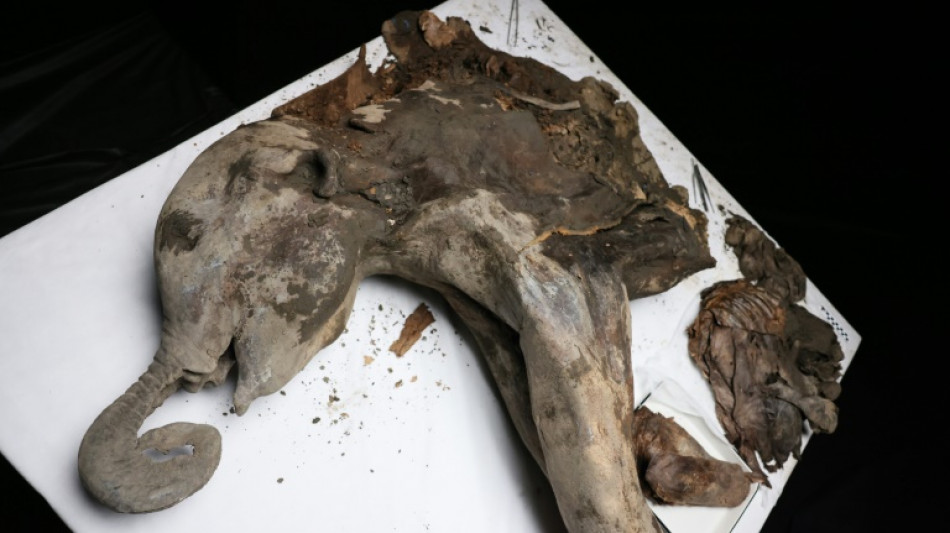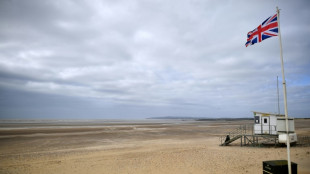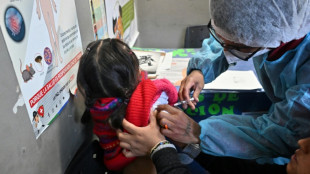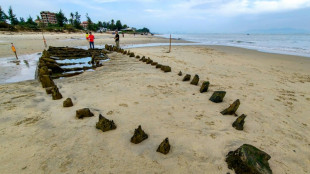
-
 AI stock boom delivers bumper quarter for Japan's SoftBank
AI stock boom delivers bumper quarter for Japan's SoftBank
-
Asian stocks struggle as US shutdown rally loses steam

-
 India probes deadly Delhi blast, vows those responsible will face justice
India probes deadly Delhi blast, vows those responsible will face justice
-
Pistons win streak hits seven on night of NBA thrillers

-
 US state leaders take stage at UN climate summit -- without Trump
US state leaders take stage at UN climate summit -- without Trump
-
Burger King to enter China joint venture, plans to double stores

-
 Iraqis vote in general election in rare moment of calm
Iraqis vote in general election in rare moment of calm
-
Philippines digs out from Typhoon Fung-wong as death toll climbs to 18

-
 'Demon Slayer' helps Sony hike profit forecasts
'Demon Slayer' helps Sony hike profit forecasts
-
Who can qualify for 2026 World Cup in next round of European qualifiers

-
 Ireland's climate battle is being fought in its fields
Ireland's climate battle is being fought in its fields
-
Sony hikes profit forecasts on strong gaming, anime sales

-
 End to US government shutdown in sight as stopgap bill advances to House
End to US government shutdown in sight as stopgap bill advances to House
-
'Western tech dominance fading' at Lisbon's Web Summit

-
 Asian stocks rise as record US shutdown nears end
Asian stocks rise as record US shutdown nears end
-
'Joy to beloved motherland': N.Korea football glory fuels propaganda

-
 Taiwan coastguard faces China's might near frontline islands
Taiwan coastguard faces China's might near frontline islands
-
Concentration of corporate power a 'huge' concern: UN rights chief

-
 Indian forensic teams scour deadly Delhi car explosion
Indian forensic teams scour deadly Delhi car explosion
-
Trump says firebrand ally Greene has 'lost her way' after criticism

-
 Show shines light on Mormons' unique place in US culture
Show shines light on Mormons' unique place in US culture
-
Ukraine, China's critical mineral dominance, on agenda as G7 meets

-
 AI agents open door to new hacking threats
AI agents open door to new hacking threats
-
Syria joins alliance against Islamic State after White House talks

-
 As COP30 opens, urban Amazon residents swelter
As COP30 opens, urban Amazon residents swelter
-
NHL unveils new Zurich office as part of global push

-
 Szalay wins Booker Prize for tortured tale of masculinity
Szalay wins Booker Prize for tortured tale of masculinity
-
Tocvan Announces Maiden Drill Program Underway at North Block Gran Pilar Gold-Silver Project

-
 'Netflix House' marks streaming giant's first theme park
'Netflix House' marks streaming giant's first theme park
-
UN warns of rough winter ahead for refugees

-
 Brazil's 'action agenda' at COP30 takes shape
Brazil's 'action agenda' at COP30 takes shape
-
Trump threatens $1 billion action as BBC apologises for edit error

-
 Sinner dominates injury-hit Auger-Aliassime in ATP Finals opener
Sinner dominates injury-hit Auger-Aliassime in ATP Finals opener
-
Trump hails Syria's 'tough' ex-jihadist president after historic talks

-
 Syria's ex-jihadist president meets Trump for historic talks
Syria's ex-jihadist president meets Trump for historic talks
-
Top US court hears case of Rastafarian whose hair was cut in prison

-
 US mediator Kushner and Netanyahu discuss phase two of Gaza truce
US mediator Kushner and Netanyahu discuss phase two of Gaza truce
-
End to US government shutdown in sight as Democrats quarrel

-
 Trump threatens air traffic controllers over shutdown absences
Trump threatens air traffic controllers over shutdown absences
-
US to remove warnings from menopause hormone therapy

-
 UK water firm says 'highly likely' behind plastic pellet pollution incident
UK water firm says 'highly likely' behind plastic pellet pollution incident
-
Syria's ex-jihadist president holds historic Trump talks

-
 End to record-long US government shutdown in sight
End to record-long US government shutdown in sight
-
France's ex-leader Sarkozy says after jail release 'truth will prevail'

-
 Atalanta sack coach Juric after poor start to season
Atalanta sack coach Juric after poor start to season
-
Trump threatens $1 billion action as BBC apologises for speech edit

-
 Gattuso wants 'maximum commitment' as Italy's World Cup bid on the line
Gattuso wants 'maximum commitment' as Italy's World Cup bid on the line
-
Indian capital car blast kills at least eight

-
 Deadly measles surge sees Canada lose eradicated status
Deadly measles surge sees Canada lose eradicated status
-
Brazil's Lula urges 'defeat' of climate deniers as COP30 opens


Yana, a 130,000-year-old baby mammoth, goes under the scalpel
Making incisions and carefully taking samples, the scientists at a laboratory in Russia's far east looked like pathologists carrying out a post-mortem.
But the body they were dissecting is a baby mammoth who died around 130,000 years ago.
Discovered last year, the calf -- nicknamed Yana, for the river basin where she was found -- is in a remarkable state of preservation, giving scientists a glimpse into the past and, potentially, the future as climate change thaws the permafrost in which she was found.
Yana's skin has kept its greyish-brown colour and clumps of reddish hairs. Her wrinkled trunk is curved and points to her mouth. The orbits of her eyes are perfectly recognisable and her sturdy legs resemble those of a modern-day elephant.
This necropsy -- an autopsy on an animal -- "is an opportunity to look into the past of our planet", said Artemy Goncharov, head of the Laboratory of Functional Genomics and Proteomics of Microorganisms at the Institute of Experimental Medicine in Saint Petersburg.
Scientists hope to find unique ancient bacteria and carry out genetic analysis of the plants and spores Yana ate to learn more about the place and time she lived.
The calf largely avoided the ravages of time because she lay for thousands of years encased in permafrost in the Sakha region in Siberia.
Measuring 1.2 metres (nearly four feet) at the shoulder and two metres long, and weighing 180 kilogrammes (nearly 400 pounds), Yana could be the best-preserved mammoth specimen ever found, retaining internal organs and soft tissues, the Russian scientists said.
- Stomach, intestines -
Dissecting her body is a treasure trove for the half-dozen scientists that were carrying out the necropsy in late March at the Mammoth Museum at North-Eastern Federal University in the regional capital, Yakutsk.
Wearing white sterile bodysuits, goggles and facemasks, the zoologists and biologists spent several hours working on the front quarters of the mammoth, a species that died out almost 4,000 years ago.
"We can see that many organs and tissues are very well preserved," Goncharov said.
"The digestive tract is partly preserved, the stomach is preserved. There are still fragments of the intestines, in particular the colon," enabling scientists to take samples, he said.
They are "searching for ancient microorganisms" preserved inside the mammoth, so they can study their "evolutionary relationship with modern microorganisms," he said.
While one scientist cut Yana's skin with scissors, another made an incision in the inner wall with a scalpel. They then placed tissue samples in test tubes and bags for analysis.
Another table held the mammoth's hindquarters, which remained embedded in a cliff when the front quarters fell below.
The scent emanating from the mammoth was reminiscent of a mixture of fermented earth and flesh, macerated in the Siberian subsoil.
"We are trying to reach the genitals," said Artyom Nedoluzhko, director of the Paleogenomics Laboratory of the European University at Saint Petersburg.
"Using special tools, we want to go into her vagina in order to gather material to understand what microbiota lived in her when she was alive."
- 'Milk tusks' -
Yana was first estimated to have died around 50,000 years ago, but is now dated at "more than 130,000 years" following analysis of the permafrost layer where she lay, said Maxim Cheprasov, director of the Mammoth Museum.
As for her age at death, "it's already clear that she is over a year old because her milk tusks have already appeared," he added.
Both elephants and mammoths have early milk tusks that later fall out.
Scientists are yet to determine why Yana died so young.
At the time when this herbivore mammal was chewing grass, "here on the territory of Yakutia there were not yet any humans", Cheprasov said, since they appeared in modern-day Siberia between 28,000 and 32,000 years ago.
The secret to Yana's exceptional preservation lies in the permafrost: the soil in this region of Siberia that is frozen year-round and acts like a gigantic freezer, preserving the carcasses of prehistoric animals.
The discovery of Yana's exposed body came about because of thawing permafrost, which scientists believe is due to global warming.
The study of the microbiology of such ancient remains also explores the "biological risks" of global warming, Goncharov said.
Some scientists are researching whether the melting permafrost could release potentially harmful pathogens, he explained.
"There are some hypotheses or conjectures that in the permafrost there could be preserved pathogenic microorganisms, which when it thaws can get into the water, plants and the bodies of animals -- and humans," he said.
F.Dubois--AMWN

